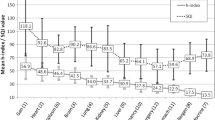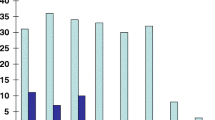Abstract
Objective
The objective of this study is to analyze up-to-date Hirsch index (h-index) data to estimate the scholarly productivity of academic radiation oncology faculty.
Methods
Bibliometric citation database searches were performed for radiation oncology faculty at domestic residency-training institutions. Outcomes analyzed included the number of manuscripts, number of citations, and h-index between 1996 and 2012. Analyses of overall h-index rankings with stratification by academic ranking, gender, and departmental faculty size were performed.
Results
One thousand thirty-seven radiation oncologists from 87 programs were included. Overall, the mean h-index was 10.8. Among the top 10 % by h-index, 38 % were chairpersons, all were senior faculty, and 11 % were women. As expected, higher h-index was associated with higher academic ranking and senior faculty status. Recursive partitioning analysis revealed an h-index threshold of 20 (p < 0.001) as an identified breakpoint between senior vs. junior faculty. Furthermore, h-index breakpoints of 12 (p < 0.001) and 25 (p < 0.001) were identified between assistant professor vs. associate professor, and associate professor vs. professor levels, respectively. Multivariate analysis identified higher academic ranking, male gender, and larger departmental faculty size as independent variables associated with higher h-index.
Conclusion
The current results suggest an overall rise in scholarly citation metrics among domestic academic radiation oncologists, with a current mean h-index of 10.8 vs. 8.5 in 2008. Significant relationships exist between h-index and academic rank, gender, and departmental size. The results offer up-to-date benchmarks for evaluating academic radiation oncologist to the national average and potentially has utility in the process of appointment and promotion decisions.

Similar content being viewed by others
References
Lee J, Kraus KL, Couldwell WT (2009) Use of the h index in neurosurgery. J Neurosurg 111:387–392
Pagel PS, Hudetz JA (2011) Scholarly productivity of united states academic cardiothoracic anesthesiologists: influence of fellowship accreditation and transesophageal echocardiographic credentials on h-index and other citation bibliometrics. J Cardiothorac Vasc Anesth 25:761–765
Rad AE, Brinjikji W, Cloft HJ et al (2010) The h-index in academic radiology. Acad Radiol 17:817–821
Spearman CM, Quigley MJ, Quigley MR et al (2010) Survey of the h index for all of academic neurosurgery: another power-law phenomenon? J Neurosurg 113:929–933
Hirsch JE (2007) Does the h index have predictive power? Proc Natl Acad Sci U S A 104:19193–19198
Hirsch JE (2005) An index to quantify an individual's scientific research output. Proc Natl Acad Sci U S A 102:16569–16572
Fuller CD, Choi M, Thomas CR Jr (2009) Bibliometric analysis of radiation oncology departmental scholarly publication productivity at domestic residency training institutions. J Am Coll Radiol 6:112–118
Choi M, Fuller CD, Thomas CR Jr (2009) Estimation of citation-based scholarly activity among radiation oncology faculty at domestic residency-training institutions: 1996–2007. Int J Radiat Oncol Biol Phys 74:172–178
Flynn DF (2009) Association of residents in radiation oncology directory: January 2009-June 2009. ARRO, Fairfax
SCOPUS (2008) Elsevier BV, Amsterdam
Ball P (2007) Achievement index climbs the ranks. Nature 448:737
Holliday E, Fuller CD, Wilson LD et al (2013) Success breeds success: authorship distribution in the Red Journal, 1975–2011. Int J Radiat Oncol Biol Phys 85:23–28
Quigley MR, Holliday EB, Fuller CD et al (2012) Distribution of the h-index in radiation oncology conforms to a variation of power law: implications for assessing academic productivity. J Cancer Educ 27:463–466
Emery SE, Gregory C (2006) Physician incentives for academic productivity. An analysis of orthopaedic department compensation strategies. J Bone Joint Surg Am 88:2049–2056
Kruse JE, Bradley J, Wesley RM et al (2003) Research support infrastructure and productivity in U.S. family practice residency programs. Acad Med 78:54–60
Morgan PB, Sopka DM, Kathpal M et al (2009) First author research productivity of United States radiation oncology residents: 2002–2007. Int J Radiat Oncol Biol Phys 74:1567–1572
Jagsi R, DeCastro R, Griffith KA et al (2011) Similarities and differences in the career trajectories of male and female career development award recipients. Acad Med 86:1415–1421
Wallner PE, Ang KK, Zietman AL, et al (2012) The American Board of Radiology Holman Research Pathway: 10-year retrospective review of the program and participant performance. Int J Radiat Oncol Biol Phys 85:29–34
Bould MD, Boet S, Sharma B et al (2011) h-Indices in a university department of anaesthesia: an evaluation of their feasibility, reliability, and validity as an assessment of academic performance. Br J Anaesth 106:325–330
Shapiro DW, Wenger NS, Shapiro MF (1994) The contributions of authors to multiauthored biomedical research papers. JAMA 271:438–442
Flanagin A, Carey LA, Fontanarosa PB et al (1998) Prevalence of articles with honorary authors and ghost authors in peer-reviewed medical journals. JAMA 280:222–224
Halperin EC, Scott J, George SL (1992) Multiple authorship in two English-language journals in radiation oncology. Acad Med 67:850–856
Mowatt G, Shirran L, Grimshaw JM et al (2002) Prevalence of honorary and ghost authorship in Cochrane reviews. JAMA 287:2769–2771
Conflict of interest statement
On behalf of all authors, the corresponding author states that there is no conflict of interest.
Author information
Authors and Affiliations
Corresponding author
Rights and permissions
About this article
Cite this article
Choi, M., Holliday, E.B., Jagsi, R. et al. Citation-based estimation of scholarly activity among domestic academic radiation oncologists: 5-year update. J Radiat Oncol 3, 115–122 (2014). https://doi.org/10.1007/s13566-013-0103-x
Received:
Accepted:
Published:
Issue Date:
DOI: https://doi.org/10.1007/s13566-013-0103-x




